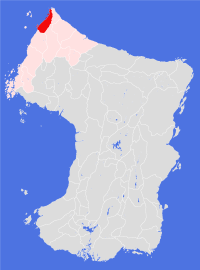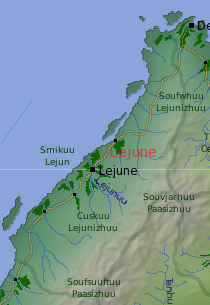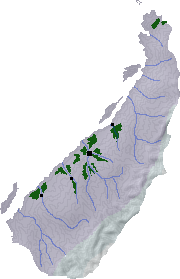Lejune

Societal ties: Bartak
Current population: 1
Main language(s): Dam Bathtel, Kanis
Area: 86,000km²
Natural and political borders
The extent of the Land of Lejune was set as part of the New Agreement in 751 as "the drainage of all rivers that reach the sea along the Smikuu Lejun, west of longitude 158.8°E and north of latitude 48.0°N". The Land extends eastwards to the Soufsuuftuu Paasizhuu, Souvjarhuu Paasizhuu and Soufwhuu Lejunizhuu ranges.
History
The decision to colonise the Smikuu Lejun was made by the Kaarname islanders in gt486, when the numbers of refugees from Cheidrah began to increase substantially. Three cultivations were started, on the large island and the mainland opposite it in the south, and along the lower reaches of the river Lejunuu. Only the Lejunuu cultivation became sustainable, and the first settlers moved from the islands to the mainland in gt497.
From the start, the cultivation proved to be problematic: many of the soil brewers who played such an important role in opening up the northwestern part of the continent spent time in Lejune learning from the successes and failures of that operation.
The main settlement period lasted until the mid gt520s, by which time Verhine plantation had become operational - from that time most refugees chose to settle in warmer, easier places. The original population, however, chose not to move: the population increased slowly and sustainably, with new settlements being opened along the coast whenever population pressures in the city required it.
Like its sister Land, Elimnarhe, to the west, Lejune has had a fairly uneventful history since its establishment. Trade between the eastern and western halves of the Bartak Lands provided some employment until new trails were opened up across the mountains in the ninth century. Lejune played no part in the war between Omne and Damose in the early gt700s. Lejune city was a founding member of the Bartekol League in gt720, and the four settlements joined together to form the Land of Lejune as part of the New Agreement in gt751.
Instead, history has been almost entirely local. In the gt790s a group of brigands moved into the north of the Land and began attacking passing ships sailing between Verhine and Dashelone, which led to Koletane merchants landing a force of mercenaries in the area in gt795. When the job was done, the mercenaries refused to leave, and started extracting tolls on traders traveling between Lejune and Destinashone. The settlements banded together to form an army which took two orbits to remove the mercenaries. After this time, the settlements provided their own fleet of ships (partly paid for by Koletane interests) to patrol the sea routes, while the army protected overland travelers. Both forces are still active today, though their role is greatly diminished - many young Lejune people have learned the art of war and defence in the Lejune forces before heading abroad to earn a living as effective (and well paid) mercenaries.
Fire has always been a concern for the city - it's burned down twice, in gt777 and again in gt982. Both times, the city was quickly rebuilt. Lejune was the first Bartak Land to build a large scale electricity generating system, principally to minimise the risk to the city of having open fires in people's houses.

Politics and economy
After much planning and work, a railway line between Verhine and Lejune was opened in gt1117, and extended to the northernmost Lejune settlement in gt1130. Plans to extend the railway line to Destinashone have been developed, and initial work has already started - if all goes to plan the extension will begin operating by gt1206. The railway line has proven to be a major boost to the local economy.
Even so, the mainstay of the economy is the agricultural sector. Lejune grows more goods than it needs, and with the arrival of the railway it has a healthy export trade with Lands to the south.
The additional money generated by this new trade has been put to good use, investing in education and manufacturing associated with new technologies. The political structures of the Land have also adapted to the expanding economy - the people of Lejune adopted a new constitutional settlement in gt1162 replacing the ad-hoc arrangements between settlements and neighbourhoods with a representative national assembly.
Even so, the role of the temple in local level politics and economics remains strong, and there has been no move to separate judicial responsibilities from the temples. The national currency is operated by the national bank, which is collectively owned by the temples.
Culture and other issues of interest
The stereotypical Lejune is shrewd, hard working and knows how to use weapons. Their humour is basic and more visual than intellectual. They also tend to be taller and stronger than other folks. Of course, this stereotype is nonsense, but all Lejune folks are happy to play up to it when they feel a need to do so.
For many Lejune, the temple is a central part of their life, thought this does not mean they are overtly religious. Temples operate as much as social clubs as places of worship. Lejune families show a marked alleigance with their temple, and most people will make an effort to attend their birth temple for important occasions.
Organised competition plays a role in every Lejune child's education - both in the sports and the arts. Group singing and theatre is preferred over individual artistic endeavour. There's also a number of amateur and semi-professional sports leagues for a variety of team games, which are heavily supported. Again, temples play a central role in these activities.
Key natural features
Lejune slopes from the mountains in the east to the coast in the west at a fairly uniform rate. Known as Cuskuu Lejunizhuu, these hills are cut by short, swift rivers transporting the heavy runoff rain back to the sea. The highest mountains on the eastern border are Mt Leje (4,630m) in the north and Mt Paase (4,990m) in the south. Four currently uninhabited offshore islands also form part of the Land.

Habitats
Western coastal habitat dominates the Land, with a thin strip of northern valleys habitat running along the eastern border.
Plantations and settlements
The land is home to four cultivations, the largest of which supports the city of Lejune. Each cultivation is situated along its own river, and no attempt has been made to extend the settlements to form a larger plantation.
Key towns and cities
Rural population: 0 (0.0% of total)